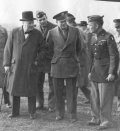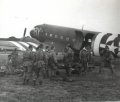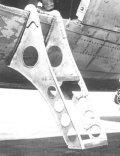|
> Club du Theil > ZOOM > Dakota (C-47 Skytrain), 101st Airborne Division, 502nd Parachutiste Infantry Regiment, few hours before the beginning of Operation OVERLORD, evening, june 5 1944, 1:48 scaled, by Renaud POUGE
| ![]() |
|
"Une armée qui craint ses supérieurs n'est jamais aussi efficace qu'une armée qui fait confiance à ses supérieurs" Gen. Dwight. D. Eisenhower, "Crusade in Europe"
The photo of General Eisenhower, Supreme Commander of the Allied Expeditionary Force Chief, with the men of the 101st Airborne Division during the day of june 51944, is maybe one of the best known from that period, but it deserve to be replaced in its context, sooooo(5 for general) difficult for the allied general in chief. For weeks, his aviation assistant, british e Leigh-Mallory hasn't stop opposing to even the idea of a airborned assault. On may 30, he announce to Eisenhower that the transport aircrafts lost will be around 50%, & the gliders one even worst, around 70%. Knowing those terribles numbers, Eisenhower visit the parachutists of 502nd P.I.R.(Parachutiste Infantry Regiment), 101st Airborne. He said in his memories intitled "Crusade in Europe" that he stayed on the field until the last plane take off. "Il était difficile d'imaginer un cas de conscience aussi déchirant (…) Si les événements venaient confirmer les prévisions, je porterais jusqu'à ma mort le fardeau insoutenable de la responsabilité d'avoir envoyé stupidement au sacrifice des milliers de soldats." Opération Overlord airborned assault initialy included only 1 airborne division, but while the plan has been reviewed, & mainly under theinfluence des generals Ridgway & Gavin (82nd AB), this number has been upped to 3 divisions, the 82nd & 101st U.S. Airborne Divisions, & the 6th British Airborne Division. The 101st Airborne, theme of this article, is place under command of general Maxwell Taylor. The definitive plan assign her the following targets : inexperimented, she will drop out in the Sainte-Mère-Eglise area, protecting Utah Beach.The targets are the village of Sainte-Mère-Eglise itself and 2 bridges over the Merderet river. This june 5 1944, on a Midlands airfield, in England, a pathfinder special force from the 101st & 82nd Airborne is preparing. These Pathfinders, around 430 men divided in around 20 sticks, whose highly secret mission is to mark out & clear from any ennemy 6 Drop-Zones (DZ) & a Landing zone (LZ) for nearly 13 200 men of the airborned troups that will be the spearhead of the Allied Expeditionary Force. 3 sticks are assigned to each of the 6 DZ while 2 are assigned to the gliders landing zone. A stick consist on 18 mens. Above those 18 men, 8 to 12 are qualified Pathfinders. He is under command of an officer who have a walkie-talkie to communicate with the 2 other officers assigned to the same DZ. Some Pathfinders received an advanced training, including transport aircraft guiding plan. This guiding plan had visual plan (phosphorescents panels & colored smokes for the day, haliphan lights for the night) as well as the use os radio devices (AN / PPN-1A Beacon, also know as Eureka beacon). As this system is so vital for the operation, 2 Pathfinders from each stick will drop out with a beacon hooked under their ventral chute. 4 other will have haliphan lights. Some Pathfinders bring to this place 2 pigeons in their tubes ; They could be use to transmit messages. The other members of the stick, unqualified Pathfinders are in charge of the security of the Pathfinders & their equipment while they will focus to guide the troup carriers. The Pathfinders commander is Capitaine Franck Lillyman, from the 502nd P.I.R., we can see him talking with General Eisenhower. He will be the 1st US parachutist on the French soil. The Eureka beacon ( AN/PPN-1A) quoted here, was the main radio guidance system. The continuous signal, sent by the beacon, was received in the leading aircraft of each wave, with the 'Rebecca' antennas system, located on each side of the C-47 cockpit. The Eureka beacon had a self-destruction device to avoid the ennemy from having it. The beacon was carried in a water resistant bag, a pocket was added to hold a pliable antenna. The BUPS beacon -- Beacon, Ultra Portable "S" Band, english mad, also equiped the Pathfinders. It was used as main navigation help for the entire division. The planes who had lost their way, would have to track its signal to drop their parachutistes. This antenna worked with a SCR-717-C radio & was carried in a cylinder shaped water resistant bag, hooked to the parachutiste harness & hold to the leg by a strap. The haliphan lights constituted the main night beaconing. The B3 crate equiped with "Rigger made" harness, contained 2 Aldis lights, that means that each Pathfinders stick had 8 lights. 7 were use to mark a DZ, identified by a color and a morse code transmitted by a light at the bottom of the T. Those lights, upped by telescopic tripod, in order to be seen from the sky and not from the soil, are lit when they hear the engines whirr. A battery is also carried in a "Rigger made" bag to give power to the lights. At 21h50 GMT, nearly 1 hour before nightfall, the 101st Airborne Pathfinders, take off from England. They will reach their DZ around 0h 20 GMT on june 6 1944. During june 5 day, Black & White stripes are applied to the IX Troop Carrier Command aircrafts , incharge of carrying the 2 US airborne Divisions. Drawn with a line or with a broom, dense & clean, letting sweat the dust under the white, or even running down the nationality markings, Michel de Trez book let us discover a wide range of invasion stripes that some, who pretend to know, will refer to. Most of the outer hinges have been covered by adhesive tape to prevent the static line from being sticked, maintaining the parachutiste to the stabilizer level he could have hurt. On each plane, next to the cargo door, the aircraft number was chalked.
The only available C-47 Skytrain (Dakota is the name given by the english) model kit, as far as i know, is the Monogram one, recently reedited to the colors of few civil companies. The original box set in its military version had the advantage to give 9parachutistes, in 3 different positions. The model is classical made for kits of that time, but remains, still today, a good quality one. There will be no big changes to add to the Monogram box. The engraving has a slight relief, but in the light of the plane caracteristics, reengraving in hollow will not be necessary. In order to give more dimension to the engines, i've chosen to represent the cooling flap in open position. This will involve to show the exhaust collector & the engines fixation system. The rounded flaps will be made in aluminium offset sheets, heated & shaped on a cylinder of the engine. The air entry on top of the engine is fined down, a new grill is made will some marriage veil. The same method is applied to the oil radiator grills, under the engines. The exhaust had a tubular shaped air entry. It will be represented by a 0.8 diameter needle. The fuel tanks caps will be in the few details to reengrave in hollow. The C-47 had 9 in formation flight lights, blue colored. 3 on each wing, & 3 on the fuselage. The will be made will 1:43 car lights covered by a translucid blue painting. The position lights are sculpted in a piece of colored ruler, they will be applied after the paintings. The landing gear is correct, only the shock absorbers will be cut & replaced by a metal tube of the required diameter. The wheels are from the "True Details" products ; thy have the advantage to show a slight crushing, and will allow to improve the fixation fo the aircraft to the diorama.
The change to the cockpit are classics. The instrument panel is replaced by holed aluminium sheet, behind it are affixed the instruments from Waldron products. He gear block is made in a resin piece, agremented with photo-découpe gears. The base of the seats would have to be removed, & rebuilt with plastic shaft ( gamme Evergreen, diam 0.035, & 0.047 inches ). The padding of the wall separating the cockpit from the radio / navigator compartment is remade with a blown plastic plate. The cockpit is a little disappointing, once closed, you can't see absolutly any interior details !!! Observing this led me not to surdetaillate the radio/navigator compartment. Same cause, same effect !!! But you will have to add a glass on the left side ; it will bring some light inside the compartment. The rear part of the fuselage ( which would be named cabin on a commercial flight ) is originally quite nice. The straps on the benches are well represented & will only need some painting. You will need to add a ceiling light, & the 2 wires on which the static lines are attached. The side windows are remade in Altuglass & glued by a really fluid glue to process with capillarity. After drying, you proceed in engraving the circles in the center of the windows. The windows will then be cleaned with auto polich to have an optimal limpidity. The Monogram kit does not represent the gliders traction system. After assembling the 2 semi fuselage, you will have to proceed a cut on the rear side of the fuselage & make the traction system with plastic card. Steps are made in plastic card. In order to obtain 2 same pieces, 2 plasticard are glued together by little cyanoacrylate glue. After drilling & cutting, they will be placed few minutes in the freezer (to reduce the action of the glue), then separated with a chirurgical blade. You will only have to realise the steps & position them. C-47 were painted in a classic scheme, olive-drad on neutral grey. But note that each plane had its on way to age. We can see, on a well known picture taked on an american airfield just before D-Day, more than 50 C-47. None have the same color, Aucun n'a la même couleur, with colors from dirty yellow to dark green. I've chosen to start on a Humbrol 155 base for the upper sides of the aircraft. This color is soften with Tan for the panels interior, & a juice is applied along the structure lines. Nationality, serial, & code - letters markings are stencil made. The invasion stripes are painted after & aged separately.
I must admit, i had this idea in my mind, since Eddy Rosier offered my a figurine representing the Supreme Command Allied Expeditionary Force Chief. The many pictures taken on june 5, is consistent enough...leaving no place to imagination. The parachutistes figurines come from 2 Monogram boxes, they have all be transform to be closer to the caracteristics of the Pathfinders. After some plastic surgery, you find on the scene, 2 operators with haliphane lights, an Eureka beacon carrier, a pigeon carrier,a BUPS beacon. In the parachutistes unqualified pathfinders, there is a sniper, a bazooka & a male nurse. As i can be seen in some of the books included in the bibliography, some picture were shot from up, this will explain why there is a photographer on the truck. The chevrolet Panel model is sracth converted on a basis of GMC CCKW 352 . You can recognize General Eisenhower with his assistant, the A.V.M. Tedder, & colonel George Van Hort Moseley in command of the 502nd P.I.R., walking aside with the 101st Airborne soldiers. As Lt Col Vandervoort, of the 505th P.I.R. (82nd AB), Moseley will break his leg in Normandy on june 6. He will be evacuated after having lost his mind & menacing his superiors with his gun. He will not be send back to the front. The resin jeep belong to General Brereton, command of 9th Air Force, & IX Troop Carrier Command. It have the standard immatriculation of the 9th Air Force vehicules. Driven by a WAAC (Woman Auxiliary Air Corps). The figurine is from "Tarmac" products, as the MP & the tricyle soldier. The Harley Davidson of the MP was scratch made. The GMC CCKW-352 is a prototype offered to me by M. Planchenault, its engraveman. The 1t Ben-hur trailer is a Tarmac product. The Command Car of General Taylor, command of 101st Airborne is a Headquarders product.
©Club du Theil | 2001 - 2004 | Contact : club-du-theil@tiscali.fr | ||
 | ||
 | ||
 | ||
 | ||
 | ||
 | ||
 | ||
 | ||
 | ||
 | ||
 | ||
 | ||
 | ||
 | ||
 | ||
 | ||
 | ||
 | ||
 | ||
 | ||
 | ||
 | ||
 | ||
New photos of the diorama :
| ||
 | ||
 | ||
 | ||
 | ||
 | ||
 | ||
 | ||
 | ||
Dakota has been used by many countries : Find here a photo gallery of the Dakota in French Navy version. | ||
|